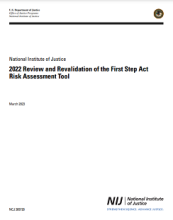Cohort studies
Group Offending and Criminal Careers: Violence Among Juvenile Delinquents and Adult Offenders, Final Report
Date Published
1996
Agencies
NIJ-Sponsored
Publication Type
Survey
Mental Disorder and Violent Crime: A 20-Year Cohort Study; Final Report
Date Published
1991
Agencies
NIJ-Sponsored
Publication Type
Survey
Analyses of Two Danish Data Sets
Date Published
1982
Agencies
NIJ-Sponsored
Age and the Changing Criminal Involvement of Ordinary Property Offenders
Date Published
1983
Agencies
NIJ-Sponsored
Publication Type
Research (Applied/Empirical)
Dual Pathways of Concealed Gun Carrying and Use from Adolescence to Adulthood over a 25-year Era of Change
Journal
Date Published
December 2024
Agencies
NIJ-Sponsored
Publication Type
Research (Applied/Empirical)
Longitudinal Cohort Study: Predictive Validity of the Structured Assessment of Violence Risk in Youth Individual/Clinical Risk Factor on Recidivism Among Mississippi Justice-Involved Youth
Date Published
2024
Agencies
NIJ-Sponsored
Publication Type
Research (Applied/Empirical)
Objective and Subjective Experiences of Childhood Maltreatment and Their Relationships with Cognitive Deficits: a Cohort Study in the USA
Journal
Date Published
September 2024
Agencies
NIJ-Sponsored
Publication Type
Research (Applied/Empirical)
Childhood Maltreatment and Midlife Cognitive Functioning: A Longitudinal Study of the Roles of Social Support and Social Isolation
Journal
Date Published
2023
Agencies
NIJ-Sponsored
Publication Type
Research (Applied/Empirical)
Inequalities in Exposure to Firearm Violence by Race, Sex, and Birth Cohort From Childhood to Age 40 Years, 1995-2021
Journal
Date Published
2023
Agencies
NIJ-Sponsored
Publication Type
Research (Applied/Empirical)
Cohort bias in predictive risk assessments of future criminal justice system involvement
Date Published
2023
Agencies
NIJ-Sponsored
Publication Type
Research (Applied/Empirical)
Nonfatal Firearm Injury and Firearm Mortality in High-risk Youths and Young Adults 25 Years After Detention
Journal
Date Published
2023
Agencies
NIJ-Sponsored,
OJJDP-Sponsored
Publication Type
Research (Applied/Empirical)
GWAs Identify DNA Variants Influencing Eyebrow Thickness Variation in Europeans and Across Continental Populations
Date Published
July 2023
Agencies
NIJ-Sponsored
Publication Type
Research (Applied/Empirical)
Associations Between Objective and Subjective Experiences of Childhood Maltreatment and the Course of Emotional Disorders in Adulthood
Journal
Date Published
2023
Agencies
NIJ-Sponsored
Publication Type
Research (Applied/Empirical)
A longitudinal cohort mixed methods study of the impact of mental health on retention and turnover among early career police officers in South Carolina
15PNIJ-23-GG-05499-RESS
Open
Funding First Awarded
2023
$1,000,000
The Need for Routine Native Nephrectomy in the Workup for Kidney Transplantation in Autosomal Dominant Polycystic Kidney Disease Patients
Journal
Date Published
July 2022
Agencies
NIJ-Sponsored
Publication Type
Research (Applied/Empirical)
Seizure incidence rates in children and adults with familial cerebral cavernous malformations
Journal
Date Published
September 2021
Agencies
NIJ-Sponsored
Publication Type
Research (Applied/Empirical)
2022 Review and Revalidation of the First Step Act Risk Assessment Tool
Date Published
March 2023
Agencies
NIJ
Publication Type
Report (Annual/Periodic),
Program/Project Evaluation
The association of neoplasms and HIV infection in the correctional setting
Date Published
2004
Agencies
NIJ-Sponsored
Publication Type
Research (Applied/Empirical)
The Cycle of Violence: Abused and Neglected Girls to Adult Female Offenders
Journal
Date Published
2021
Agencies
NIJ-Sponsored
Publication Type
Research (Applied/Empirical)
Crime and Justice: A Review of Research, Volume 30
Date Published
2003
Agencies
NIJ
Publication Type
Collected Work
Marian House Research Project: Final Report -- Grant 5-1519-MD-DD
Date Published
1996
Agencies
NIJ
Publication Type
Report (Study/Research)
Shift work and overtime across a career in law enforcement: a 15-year study
Date Published
2021
Agencies
NIJ-Sponsored
Publication Type
Research (Applied/Empirical)
Social change and cohort differences in group-based arrest trajectories over the last quarter-century
Date Published
2021
Agencies
NIJ-Sponsored
Publication Type
Research (Applied/Empirical)




